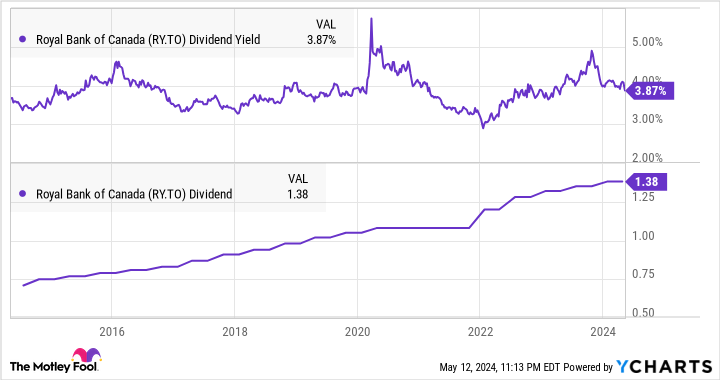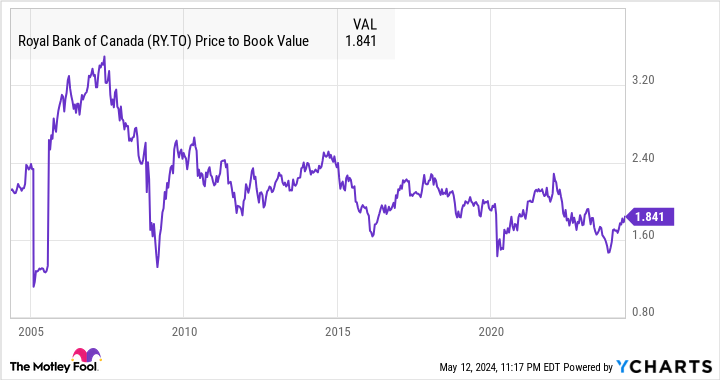Is RBC a Buy, Sell, or Hold?

Written by Kay Ng at The Motley Fool Canada
Royal Bank of Canada (TSX:RY) is a solid long-term investment. In the last five, 10, and 20 years, it delivered annualized total returns of approximately 10.3%, 11.1%, and 12.3%, respectively. To be more concrete, it turned an initial investment of $10,000 into roughly $16,290, $28,680, and $102,230, respectively.
A good portion of these returns came from its dividend, which RBC has increased over time. Currently, the stock offers a dividend yield of 3.9%. Since the Canadian banking leader pays a safe dividend, the dividend yield is a good gauge of the stock’s valuation.
Here’s a 10-year history of the stock’s dividend yield range and quarterly dividend. The current dividend yield indicates that the stock is not exactly a bargain. Based on the decade’s yield history, RBC stock is likely a good buy whenever it offers a dividend yield of close to 5%.
RY Dividend Yield data by YCharts
Let’s take an actual look at its valuation. At about $141 per share at writing, which is a price to book of about 1.8 times. In recent history, it dipped to below 1.6 times book.
RY Price to Book Value data by YCharts
At this quotation, it trades at a blended price-to-earnings ratio of approximately 12.5 times, which aligns with its long-term normal valuation. Both valuation metrics suggest a stock that’s not cheap. Analysts agree that the stock is fairly valued as the TMX Group website has a consensus 12-month price target of $143.40 on the stock.
This means there’s no margin of safety in the stock. It doesn’t mean that owners of RBC stock should sell immediately because there’s value in earning a perpetual income. For example, investors who bought RBC shares about 15 years ago are sitting on a yield on cost of about 11.8%. Imagine earning a +11.8% return on your investment perpetually (no matter what the economy or financial markets are doing).
Besides, its long-term returns from current levels aren’t bad. Assuming a fairly valued stock and the bank is able to grow its earnings per share by about 6% per year going forward, long-term investors could still get long-term returns of more or less 10% when combining price appreciation from earnings growth and its dividend.
In most years, the Canadian bank stock maintains a payout ratio of about 50%, which protects its dividend and allows for dividend growth over time, along with earnings growth. Investors need to beware of economic downturns, which would be a drag on RBC’s earnings. That said, even during recessions, RBC’s earnings have been resilient. Today, the bank operates a diversified business, consisting of about 39% revenue generation from personal and commercial banking, 31% from wealth management, 20% capital markets, and 10% insurance, based on fiscal 2023 revenue.
In today’s higher interest rate environment, Canadians are experiencing higher interest rates, which could lead to higher levels of bad loans, especially if a recession occurs. This is why it’s also unlikely RBC shares will head much higher over the next 12 months.
All in all, RBC stock appears to be a “hold” at current levels because shares are fully valued, but it pays out a safe and growing dividend, offering a decent dividend yield of 3.9%. On dips of 10% or more (or a price target of below $127) within the next year is a good starting point to consider accumulating shares.
The post Is RBC a Buy, Sell, or Hold? appeared first on The Motley Fool Canada.
Should you invest $1,000 in Royal Bank of Canada right now?
Before you buy stock in Royal Bank of Canada, consider this:
The Motley Fool Stock Advisor Canada analyst team just identified what they believe are the 10 best stocks for investors to buy now… and Royal Bank of Canada wasn’t one of them. The 10 stocks that made the cut could potentially produce monster returns in the coming years.
Consider MercadoLibre, which we first recommended on January 8, 2014 ... if you invested $1,000 in the “eBay of Latin America” at the time of our recommendation, you’d have $15,578.55!*
Stock Advisor Canada provides investors with an easy-to-follow blueprint for success, including guidance on building a portfolio, regular updates from analysts, and two new stock picks each month – one from Canada and one from the U.S. The Stock Advisor Canada service has outperformed the return of S&P/TSX Composite Index by 32 percentage points since 2013*.
See the 10 stocks * Returns as of 3/20/24
More reading
Can You Guess the 10 Most Popular Canadian Stocks? (If You Own Them, You Might Be Losing Out.)
How to Build a Bulletproof Monthly Passive-Income Portfolio in 2024 With Just $25,000
Fool contributor Kay Ng has positions in Royal Bank Of Canada. The Motley Fool recommends TMX Group. The Motley Fool has a disclosure policy.
2024

 Yahoo Finance
Yahoo Finance 

